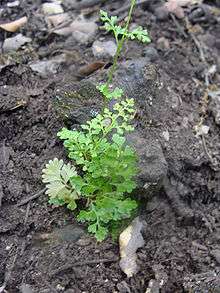Anogramma leptophylla
Anogramma leptophylla, sometimes called Jersey fern,[1] is a species of fern in the family Pteridaceae.[2] It is found worldwide in temperate and subtropical regions. A rarity in the Pteridophyta, it is a fern whose sporophyte tends to have an annual life cycle.[3] The gametophytes of this species have the ability to become dormant and wait as much as two and a half years until conditions are appropriate for the sporophyte stage of the life-cycle.[4]
| Anogramma leptophylla | |
|---|---|
 | |
| Scientific classification | |
| Kingdom: | Plantae |
| Clade: | Tracheophytes |
| Class: | Polypodiopsida |
| Order: | Polypodiales |
| Family: | Pteridaceae |
| Genus: | Anogramma |
| Species: | A. leptophylla |
| Binomial name | |
| Anogramma leptophylla (L.) Link | |
| Synonyms | |
|
Anogramma caespitosa | |
Description
Anogramma leptophylla is a small annual fern, seldom exceeding 3 in (8 cm) in height. It has delicate, two-pinnate fronds, only the inner ones being fertile and bearing linear spore cases on the undersides of the nearly circular leaflets, occupying most of their surface area. The leaf margins are not curled.[5]
Distribution and habitat
Anogramma leptophylla has an oceanic temperate distribution. It is found in the Mediterranean area (southern France, Italy) and is widespread in North America. The only place in the British Isles in which it occurs is the island of Jersey in the Channel Islands. It grows on walls and banks, especially when there is underlying granite rock. It prefers to grow on bare soil in moist but well-drained locations as it is not very competitive.[3]
Ecology
Other plants growing in the same habitats include the pellitory-of-the-wall Parietaria lusitanica and the Mediterranean clubmoss (Selaginella denticulata) in northern Italy, and the clubmoss, the liverwort Targionia hypophylla and the mosses Rhynchostegiella tenella and Timmiella anomala in Elba. These plants are all heat-loving and are able to survive the winter by growing in locations where warm water seeps out of crevices, giving a tropical microclimate.[6]
References
- "BSBI List 2007". Botanical Society of Britain and Ireland. Archived from the original (xls) on 2015-01-25. Retrieved 2014-10-17.
- Christenhusz et al., 2011 Maarten J. M. Christenhusz, Xian-Chun Zhang & Herald Scheider: "A linear sequence of extant families and genera of lycophytes and ferns," Phytotaxa, 19: 7-54 (18 Feb. 2011)
- "Anogramma leptophylla". Online Atlas of the British and Irish Flora. Retrieved 21 March 2020.
- Pangua, Emilia; Pérez-Ruzafa, Isabel; Pajarón, Santiago (2011). "Gametophyte Features in a Peculiar Annual Fern, Anogramma leptophylla". Annales Botanici Fennici. 48 (6): 465–472. doi:10.5735/085.048.0604.CS1 maint: multiple names: authors list (link)
- McClintock, David; Fitter, R.S.R. (1961). The Pocket Guide to Wild Flowers. Collins. p. 301.
- Segal, S. (2013). Ecological Notes on Wall Vegetation. Springer. pp. 146–147. ISBN 978-94-017-6232-8.
- Molnár, C. et al. 2008., Remote, inland occurrence of the oceanic Anogramma leptophylla (L.) Link (Pteridaceae: Taenitidoideae) in Hungary, Amer. Fern J., 98(3): 128 - 138.